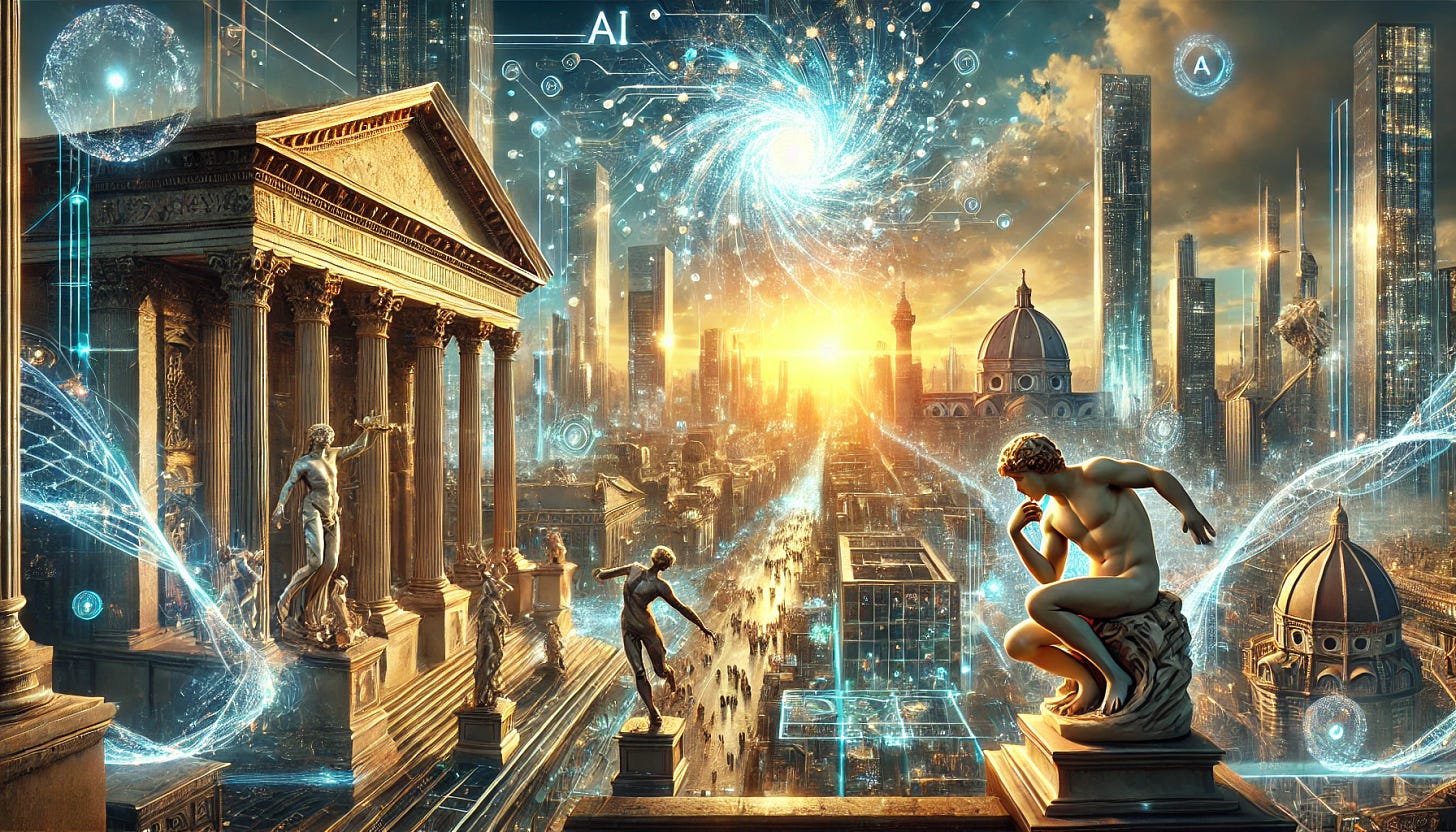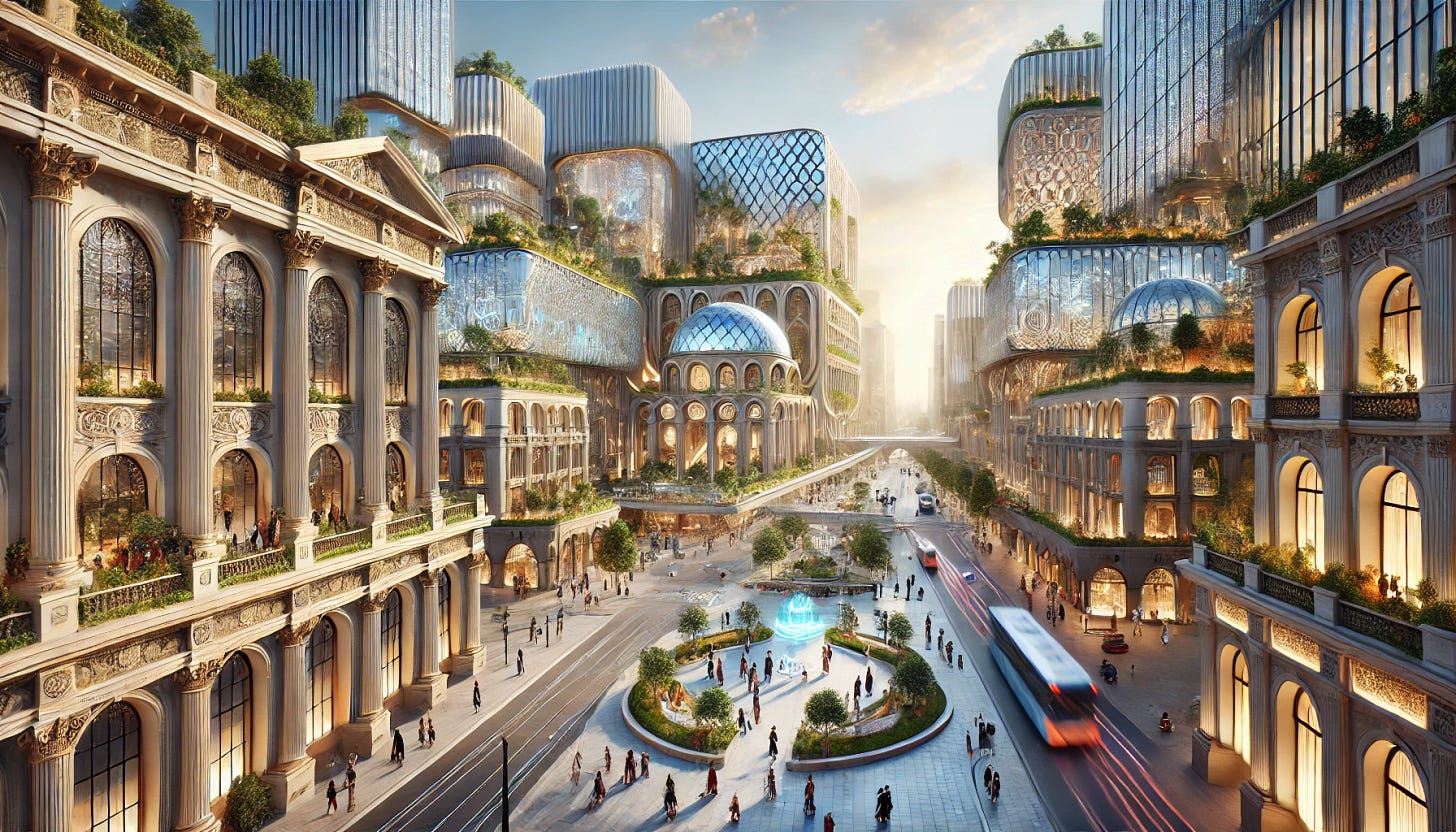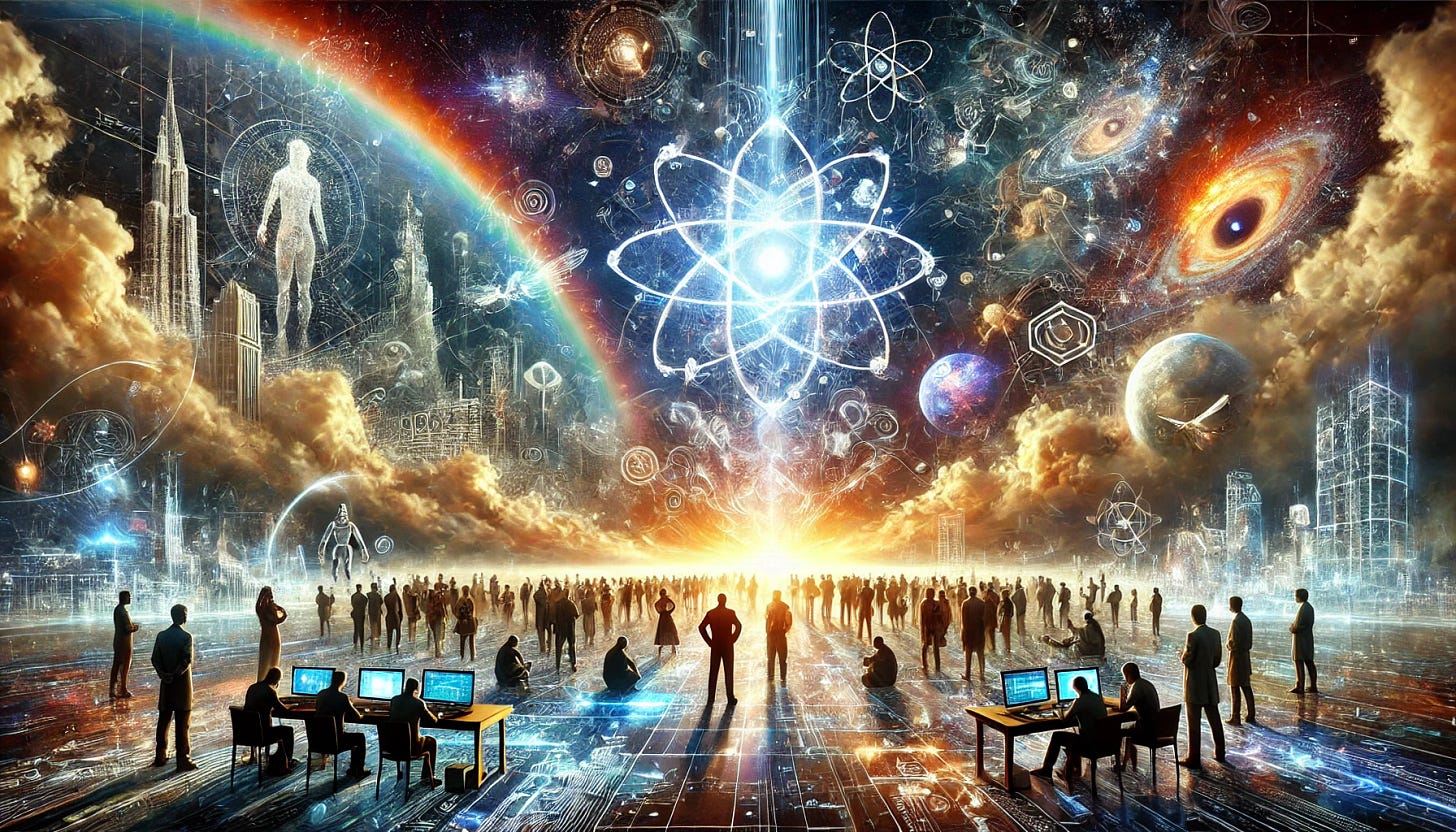Announcing the Second Renaissance: AI, Singularity, and Humanity’s Next Leap - Part 2
The Second Renaissance is here—AI, AGI, and human potential are converging to reshape our future. Will we rise to the challenge?
Where Do We Go From Here?
In Part 1, we explored the striking parallels between the original Renaissance and the transformative era we are now entering—a Second Renaissance driven by Artificial Intelligence, AGI, and the rapid acceleration of technological progress. The first Renaissance was not merely about rediscovering ancient knowledge; it was about building something new, something greater than what came before.
Today, we face the same opportunity. AI is not just a tool—it is a force reshaping creativity, labour, healthcare, and even human evolution itself. But how do we ensure that this transformation serves humanity’s highest aspirations rather than simply accelerating economic and technological disparity?
In Part 2, we will explore the lessons we can take from the Renaissance, the importance of creating inspiring and livable futures, and what it means to shape a world where innovation aligns with our deepest values.
What We Can Learn from the Renaissance
The Renaissance was not just a time of artistic mastery and scientific discovery—it was a period of multidisciplinary innovation, where the barriers between disciplines dissolved. The great minds of the era did not limit themselves to one domain; they saw knowledge as a vast interconnected web, where breakthroughs in one field could inspire new discoveries in another.
Leonardo da Vinci, often regarded as the ultimate Renaissance Man, was not only a master painter but also an engineer, anatomist, and inventor. His studies of human anatomy informed his art, while his engineering concepts laid the groundwork for machines that wouldn’t be realised for centuries. Galileo Galilei was not just a physicist but a philosopher and astronomer who challenged dogma and reshaped humanity’s understanding of the cosmos. This era of cross-disciplinary thinking fuelled an explosion of progress that continues to shape our world today.
By contrast, much of modern progress has been shaped by specialisation—a system that segments knowledge into isolated disciplines, where scientists, technologists, and artists often work in silos. While specialisation has driven deep expertise, it has also limited the cross-pollination of ideas that once led to revolutionary breakthroughs. The Second Renaissance must go beyond this, embracing interdisciplinary collaboration as the driving force behind human progress.
Reintegrating Knowledge in the Age of AI
AI, automation, and AGI are not just advancing individual disciplines—they are reshaping the very way we interact with knowledge itself. AI can analyse vast amounts of information across fields, identifying patterns that human minds alone might miss. This offers us an unprecedented opportunity to blend disciplines in ways never before possible.
Imagine an era where:
Artists and engineers collaborate with AI to create immersive, meaningful digital experiences that redefine human expression, using generative AI to craft experiences that merge aesthetics with interactive design.
Ethicists and neuroscientists work with AGI researchers to ensure that AI systems evolve with human values in mind, embedding ethical considerations at the core of AI development rather than as an afterthought.
Philosophers and technologists reimagine economic models, ensuring that post-labour abundance leads to equity and shared prosperity rather than deepening existing inequalities.
Medical researchers, geneticists, and AI developers work together to unlock radical longevity, using AI to process genetic data, predict disease patterns, and extend the quality of human life.
The possibilities are boundless, but only if we choose to integrate knowledge rather than isolate it.
The first Renaissance thrived because of a shared belief in human potential. It was driven by a sense of wonder and the conviction that progress is not just necessary, but possible. If we embrace that same spirit today, AI can help us create a society that is not only more innovative but also more equitable, interconnected, and aligned with our highest aspirations.
This is the challenge—and the opportunity—of the Second Renaissance. Will we seize it?
Shaping Livable and Beautiful Futures
The Renaissance gave birth to some of the most breathtaking and human-centred urban designs in history. Cities like Florence, Venice, and Rome were not just centres of commerce and power; they were living testaments to the idea that architecture should inspire and serve as a reflection of human potential. Public spaces were designed not merely for function but to foster connection, creativity, and a shared civic spirit. The great plazas, cathedrals, and bridges of the era were not just feats of engineering—they were works of art, embodying balance, beauty, and proportion in ways that continue to captivate the world today.
Yet, as we look at modern urban landscapes, particularly in the developing world, much of this sense of purpose has been lost. Cities are increasingly shaped by economic expediency rather than human experience—high-density housing blocks, sprawling concrete developments, and soulless skyscrapers that prioritise efficiency over inspiration.
Now, in the Age of AI, we must ask: What kind of world do we want to build?
Smart Cities vs. Human Cities: Efficiency or Meaning?
The push for Smart Cities—driven by AI, automation, and hyper-efficiency—has focused heavily on optimisation: streamlining transportation, reducing energy consumption, and maximising economic output. AI-powered systems are now being integrated into city planning to monitor traffic, manage energy grids, and optimise urban logistics. These are undoubtedly important advancements, but efficiency alone is not enough to make cities livable, inspiring, or humane.
A world designed purely by algorithms, driven by economic models that prioritise GDP growth and real estate profits, risks losing the very elements that make cities vibrant, communal, and culturally rich. The future of urban living must not be solely about smart systems—it must be about human-centred design.
Instead of just Smart Cities, we should strive for Human Cities—places where AI enhances creativity, sustainability, and human well-being, not just logistics and optimisation.
Making Cities Beautiful Again
One of the greatest failures of modern urban design is the neglect of aesthetics—the idea that cities should delight and inspire. Renaissance cities were beautiful because they embraced harmony, proportion, and craftsmanship. Today, however, many modern cities, especially in the developing world, have been built with cheap, repetitive, and monotonous designs that lack character or soul.
But it doesn’t have to be this way. AI-powered architecture and urban planning can help us rediscover the lost art of city-making, allowing us to build spaces that are not only efficient but stunningly beautiful.
Imagine a future where:
AI-driven architecture adapts to the emotional and psychological needs of its inhabitants, creating organic, flowing designs that feel warm and welcoming rather than sterile and rigid.
Traditional and modern aesthetics are blended, using AI to analyse historical design principles and integrate them into new urban developments, preserving cultural identity while embracing innovation.
AI-assisted community design enables local populations to shape their own neighbourhoods, ensuring that the built environment reflects the values, traditions, and creative input of its people.
Automated construction technologies make it affordable to build beautifully again, enabling high-quality craftsmanship at a fraction of today’s costs.
The third world, in particular, has the greatest opportunity to rethink urban development from the ground up. Instead of repeating the mistakes of Western industrialisation—where beauty was sacrificed for profit—developing nations can leapfrog into a future where AI-driven planning, 3D-printed infrastructure, and sustainable materials make stunning, functional cities accessible to all.
Reclaiming Public Spaces for Culture and Creativity
Beyond architecture, cities must also be designed to promote social interaction, art, and creative expression. Many modern urban environments have become isolated, soulless collections of buildings where people commute rather than engage with their surroundings. This is a failure of imagination.
During the Renaissance, public squares, gardens, and communal gathering spaces were integral to daily life. These were places where artists could showcase their work, where philosophers could debate, and where citizens could engage in a shared cultural experience.
Now, imagine:
Public spaces designed for creativity, where digital and physical art merge to form ever-changing environments that inspire learning, play, and connection.
AI-powered cultural hubs that host real-time artistic collaborations between human creators and AI-generated designs.
Interactive environments where architecture adapts dynamically to events, lighting up with history, storytelling, and augmented reality experiences that connect people with their surroundings in meaningful ways.
The Role of AI in Urban Transformation
AI has the power to revolutionise urban planning and development—but only if we use it wisely. If AI is solely employed to maximise cost efficiency, we will continue to see uninspired concrete jungles sprawling across the planet. However, if AI is harnessed as a tool for creativity and culture, it can help us restore the lost art of city-making and design spaces that inspire human flourishing.
The question is no longer can we make our cities beautiful again, but will we?
Just as the Renaissance transformed European cities into centres of culture, knowledge, and innovation, the Second Renaissance must aim to reshape our world into one that is not only technologically advanced but profoundly meaningful.
It’s time to build cities worthy of the people who live in them.
Creating a Future Worth Aspiring To
Every great transformation in human history has been driven by vision. The Renaissance was not merely an era of artistic and scientific achievement—it was a testament to the boundless potential of human imagination. It was an age where the old constraints of knowledge, culture, and society were broken, and a new world emerged, built upon the audacity to imagine better.
Today, we stand on the threshold of an even greater transformation. The fusion of AI, AGI, and human ingenuity presents us with possibilities once confined to science fiction. But technology, by itself, does not dictate destiny. It is not AI that will determine the world we live in—it is us.
The Questions That Will Define Our Era
AI will not automatically lead us toward a utopia, nor will it inevitably bring dystopia. It is a tool—one that reflects the intentions, values, and priorities of those who wield it. The true challenge lies not in the technology itself but in the choices we make about how to shape it.
We must ask ourselves:
Will AI accelerate creativity and abundance, or will it reinforce existing inequalities?
AI has the power to democratise access to knowledge, education, and wealth, breaking down barriers that have existed for centuries. But if left in the hands of a few, it could also deepen societal divides. Do we use AI to empower the many or to entrench the privileged?
Will we build AI-driven economies that uplift humanity, or will we allow automation to concentrate power in the hands of the few?
The automation revolution is already reshaping industries, but how we respond to this shift will define our collective future. Will we embrace Universal Basic Income (UBI) and new models of economic prosperity? Or will we allow outdated systems to persist, widening the gap between those who have and those who do not?
Will we use AI to amplify human potential, or will we surrender our agency to machines?
AI should enhance human ingenuity, not replace it. As we move toward AGI, we must ensure that AI is developed in ways that respect human creativity, autonomy, and dignity. This is not a question of whether AI can think for us, but whether we choose to remain active participants in shaping our own future.
A Call to Bold Imagination
The Renaissance did not happen by accident. It was the result of bold visionaries—artists, philosophers, scientists, and explorers—who dared to challenge convention and reimagine what was possible. They did not simply accept the world as it was; they actively reshaped it.
Today, we must do the same. The Second Renaissance is not a distant dream—it is happening right now. The forces of AI, automation, and human-machine collaboration are already in motion. What remains is how we choose to direct them.
This is not just about innovation—it’s about values. It’s about choosing to create a future where technology serves humanity, rather than the other way around. It’s about ensuring that AI becomes a tool for expansion, empowerment, and enlightenment—not just efficiency and profit.
The Future Begins With Us
As we step into this new era, we must embrace the same spirit of courage and curiosity that fuelled the Renaissance. We must see ourselves not as passive observers of technological progress but as architects of the world to come.
The question is no longer if the Second Renaissance will happen. It is happening. The real question is:
👉 What role will you play in shaping it?
This is our moment. Let’s build a future worth aspiring to.
Shaping the Second Renaissance—Be Part of the Future
The journey into the Second Renaissance does not end here—it is only just beginning. If this vision of AI, Singularity, and human evolution resonates with you, I invite you to join the conversation.
💡 How do you see AI shaping the future? Drop your thoughts in the comments and let’s discuss.
🔗 Follow me on 𝕏 @frankdasilva for real-time insights and bold ideas and explore my broader work at Frank Da Silva – Living the Future.
✨ Please consider supporting MyGeekSpace as a paid subscriber for exclusive content and in-depth explorations into the future of AI, humanity, and consciousness. Unlock exclusive insights on Patreon—get behind-the-scenes access to bold ideas, in-depth explorations, and the future as it unfolds.
Let’s shape the future together. #LivingTheFuture











